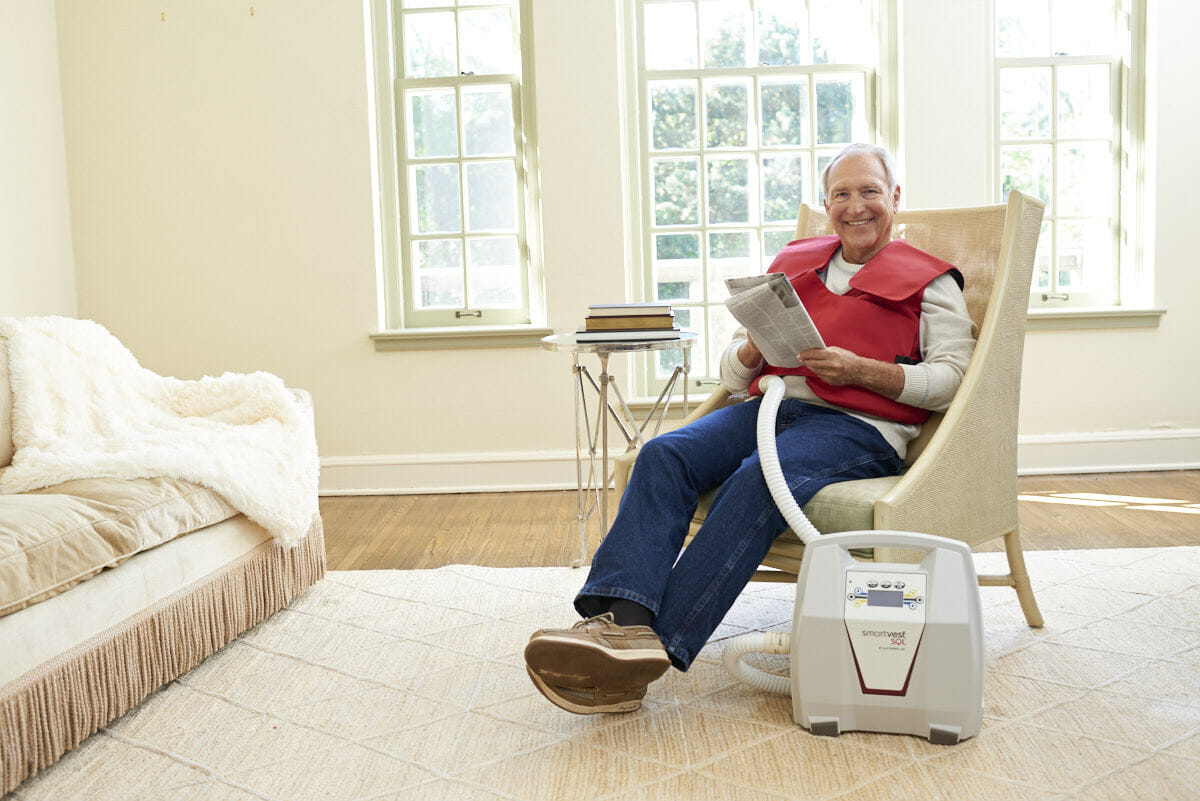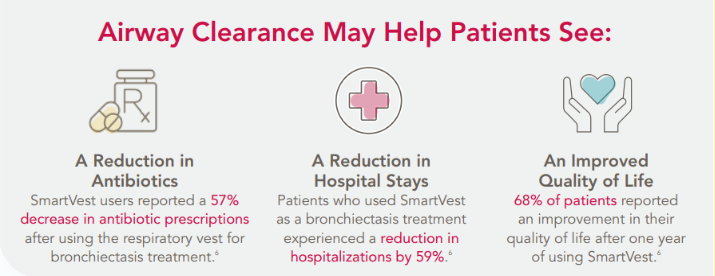 Most of us are familiar with the acronym COPD (Chronic Obstructive Pulmonary Disease). Used as an umbrella term to describe progressive lung diseases including emphysema, chronic bronchitis, and refractory asthma, COPD can occur from smoking, certain environmental factors, or an individual’s genetic makeup.1
Most of us are familiar with the acronym COPD (Chronic Obstructive Pulmonary Disease). Used as an umbrella term to describe progressive lung diseases including emphysema, chronic bronchitis, and refractory asthma, COPD can occur from smoking, certain environmental factors, or an individual’s genetic makeup.1
Common symptoms of COPD include shortness of breath, wheezing, tightness in your chest, and chronic cough. Like bronchiectasis—another chronic lung condition that shares many similarities with COPD—these symptoms are irreversible. This means if your lungs become damaged from repeated respiratory infections and inflammation, the damage is permanent and can eventually lead to bronchiectasis.
According to the COPD Foundation, there are a variety of treatments available to help COPD patients manage their symptoms and prevent flare ups (a worsening of symptoms) from disrupting their quality of life. Treatments may include certain medications that help dilate the airways to increase airflow into your lungs. These are typically broken down into two categories: controllers (to help maintain healthy airflow) and rescue medications (to help you manage symptoms at the onset of flare ups).2 These types of medications can be administered through an inhaler or nebulizer. Though such medications can help prevent or treat the onset of COPD symptoms, an effective long-term approach to managing an impaired breathing condition is with airway clearance.
Why is Airway Clearance an Effective Method for Treating Chronic Lung Conditions?
Respiratory infections are often a result of bacteria in the lungs. When a chronic lung condition like COPD or bronchiectasis disrupts natural airflow, our lungs begin to lose their ability to clear mucus on their own, making us more susceptible to repeated infection and inflammation.
Antibiotics and medications can help fight infection, but airway clearance can help prevent mucus buildup and slow disease progression.3
There are a variety of airway clearance techniques that are either performed manually, through a handheld device, or respiratory vest. Popular methods of airway clearance include:
Coughing and Huffing Techniques
Referred to as the “huff cough”, this breathing technique is performed as an extension of your airway clearance technique. The exercise works by inhaling three equal breaths, while pulling in your abdomen and making a “huff” sound in the back of your throat.4
See more on how to do a huff cough.
Manual Chest Physiotherapy
This technique requires the assistance of a caregiver or therapist to perform a series of manual claps on the patient’s chest wall. The repeated vibrations from the claps help break up mucus and move it from the patient’s smaller airways to the larger ones.
High Frequency Chest Wall Oscillation (HFCWO) Therapy
HFCWO therapy via the SmartVest Airway Clearance System can be performed without assistance and conveniently fits as a vest around a person’s chest for added comfort and convenience. It works by delivering rapidly repeating pulses of air that squeeze and release the chest wall, which helps to thin and loosen mucus so that it can be easily propelled to the larger airways and coughed out.
Why is HFCWO Therapy a Recommended Treatment Option?
HFCWO therapy is recommended for patients living with COPD, bronchiectasis, cystic fibrosis, and other impaired breathing conditions. The SmartVest uses a unique open system design with “active inflate – active deflate,” making deep and easy breaths possible during treatment. Aside from its sleek, lightweight design, the SmartVest system has shown to reduce respiratory flare ups, saving patients money on hospital visits, antibiotic medications, and emergency trips to the hospital. In a longitudinal outcome-based study, approximately 68 percent of patients who were experiencing symptoms of bronchiectasis reported, at will, a significant improvement in their quality of life and a reduction in the severity of their exacerbations.5

Graphic citation: 6
What are COPD and Bronchiectasis Patients Saying About HFCWO Therapy?
Whether you’re living with COPD or bronchiectasis, SmartVest offers a proactive, comfortable solution to therapy treatment that allows you to manage your individual symptoms. Performed twice a day, SmartVest is clinically proven to reduce healthcare costs and improve your quality of life. This means you spend more time doing the things you love most and less time dealing with worsening symptoms disrupting your lifestyle.
Read what SmartVest users have to say about HFCWO therapy and how the SmartVest has helped them regain their independence and ability to breathe better.
“Within days after using it I was sleeping better, the flare ups grew farther apart, and I haven’t been sick for almost a year and a half!” -Nancy
“I used to get up coughing every morning and now I don’t. Before I got SmartVest, I just didn’t think I had much life left. I’m afraid not to use it!” -Patricia
“When a person can breathe better and a little easier, it makes such a huge difference in the quality of their life. My husband used the SmartVest for COPD and it helped him a lot.” -Roberta
“My husband started SmartVest when he was in the hospital. What a difference it makes. We love it; it helps get the phlegm up.” -Judy
To learn more about COPD and bronchiectasis, visit our resource page to find information from other organizations that work to support individual lung diseases and conditions.
References:
[1] COPD Foundation. “What Causes COPD?” Retrieved from https://www.copdfoundation.org/What-is-COPD/Understanding-COPD/What-Causes-COPD.aspx
[2] COPD Foundation. “COPD Treatments.” Retrieved from https://www.copdfoundation.org/Learn-More/I-am-a-Person-with-COPD/Treatments-Medications.aspx
[3] O’Donnell AE, Aksamit TR. Abstracts: 3rd World Bronchiectasis Conference. Chronic Obstr Pulm Dis. 2018; 5(4): 302-323. doi: http://dx.doi.org/10.15326/jcopdf.5.4.2018.0132.
[4] American Thoracic Society. “Treating Bronchiectasis.” Retrieved from https://www.thoracic.org/patients/patient-resources/resources/bronchiectasis.pdf
[5] SmartVest. “Incidence of Bronchiectasis-Related Exacerbation Rates After High Frequency Chest Wall Oscillation (HFCWO) Treatment—A Longitudinal Outcome-Based Study.”
[6] SmartVest. “Using High Frequency Chest Wall Oscillation in a Bronchiectasis Patient Population: An Outcomes-Based Case Review.”

